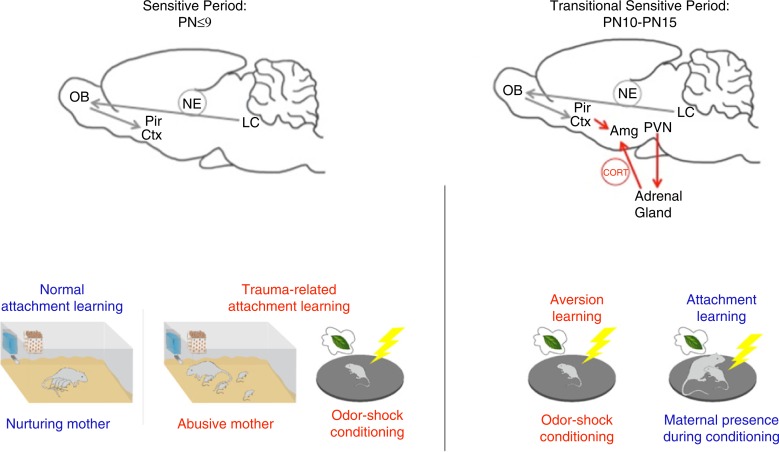Fig. 1.
Using a fear conditioning paradigm of odor-shock presentations has enabled us to uncover a developmentally unique learning system in pups that typically supports attachment learning. Data indicate that during the sensitive period for attachment learning (PN≤9), low CORT levels block amygdala plasticity to prevent pups from learning amygdala-dependent fear/threat. Instead, this learning paradigm activates the attachment learning neural circuit involving NE to produce approach responses to the odor (Moriceau et al., 2006). The odor also takes on qualities of the maternal odor to support nipple attachment and enhance prosocial behaviors to the mother. In pups older than PN9, this fear conditioning paradigm accesses the amygdala to support fear/threat learning if the pup is alone. A critical feature of this learning is that shock induces activation of the HPA axis and CORT release, which is necessary for the young amygdala to learn. However, if the mother is present, she socially buffers the pup’s stress response, and pups revert to sensitive period learning and learn an odor preference. This mother-controlled switch between fear and attachment learning is mediated through the mother’s ability to control pups’ CORT (Moriceau, Wilson et al., 2006). A more adult-like fear learning system, which cannot be switched on/off by CORT, develops by PN15. Environmental variables that control pups’ CORT level, such as receiving CORT from a stressed mother via milk, environmental manipulations that increase pups’ CORT (exogenous CORT administration and abusive rearing), or the mother’s ability to socially buffer the pups (compromised in abusive mothers) have the potential to modify the age of these transitions and whether a pup learns fear or attachment (Moriceau & Sullivan, 2006; Perry & Sullivan, 2014; Raineki et al., 2012; Shionoya et al., 2007; Sullivan & Holman, 2010).

